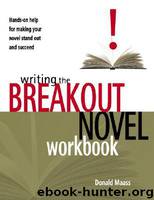Writing the Breakout Novel Workbook by Donald Maass

Author:Donald Maass [Maass, Donald]
Language: eng
Format: epub, pdf
Published: 2011-03-27T07:00:00+00:00
Step 2: Heighten it. Change the setting in some way. Make the action bigger. Magnify the dialogue. Make the inner change experienced by your point-of-view character as cataclysmic as an earthquake.
Step 3: Take the same moment, and underplay it. Make it quieter. Take away action. Remove dialogue. Make the transition small and internal, a tide just beginning to ebb.
Follow-up work: Go through your novel and find the turning points in twenty scenes. Find ways to heighten (or pointedly diminish) them.
Conclusion: Most manuscripts I read do not feel dynamic. The stories do not stride forward in pronounced steps. Many authors are afraid of exaggerating what is happening, of appearing arty. That is a mistake. Stories, like life, are about change. Delineating the changes scene by scene gives a novel a sense of unfolding drama, and gives its characters a feeling of progress over time.
The Inner Journey
Plot developments create easy-to-see turning points. Less easy to identify are your protagonist's inner turning points: the moments when self-perception changes. Call it growth, call it exposition, call it whatever you like. It is when we get inside your hero's head and find out who he is right now.
In City of Bones, Michael Connelly's protagonist is homicide detective Hier-onymous (Harry) Bosch. Harry, as I discussed earlier, is Connelly's series hero, but Connelly does not keep him emotionally frozen. Harry evolves. Toward the end of City of Bones, Harry finds himself again in hot water for a serious breach of police department regulations. He expects to be forced to retire. Instead, he is given an unexpected promotion and is moved to the downtown Los Angeles precinct. Although this is so that he can be watched more closely, it nevertheless is an unexpected boon:
Now it was Bosch who was having the drink and falling asleep in his chair. He sensed he was at a threshold of some sort. He was about to begin a new and clearly defined time in his life. A time of higher danger, higher stakes and higher rewards. It made him smile, now that he knew no one was watching him.
Harry does indeed begin a new phase at the end of the story, though not the expected one. (See chapter twenty.) Paradoxically, because Connelly is so careful to pinpoint his hero's inner turning points along the way, we are never sure where those turnings of heart, soul, and mind will lead. Unchanging characters cannot surprise. Dynamic characters take us on journeys, and journeys necessarily involve surprises. Think about it: When did a lengthy trip in your own life ever go exactly as expected? Not often, I bet.
In Mystic River, Dennis Lehane tells the story of three Boston friends, Sean Devine, Jimmy Marcus and Dave Boyle, who, as we know from earlier excerpts, were present together at a childhood tragedy: Dave's abduction by two roving child molesters. In the present day the tragedy assumes Greek proportions as Jimmy slowly becomes convinced that Dave has murdered
Jimmy's teenaged daughter, Katie. He kills Dave, but immediately learns from Sean that he was wrong: Dave has committed a murder, but not Katie's.
Download
Writing the Breakout Novel Workbook by Donald Maass.pdf
This site does not store any files on its server. We only index and link to content provided by other sites. Please contact the content providers to delete copyright contents if any and email us, we'll remove relevant links or contents immediately.
| Authorship | Bibliographies & Indexes |
| Book Industry |
Autoboyography by Christina Lauren(4699)
Asking the Right Questions: A Guide to Critical Thinking by M. Neil Browne & Stuart M. Keeley(4634)
Dialogue by Robert McKee(3619)
Eat That Frog! by Brian Tracy(3559)
Sticky Fingers by Joe Hagan(3473)
Journeys Out of the Body by Robert Monroe(3024)
Elements of Style 2017 by Richard De A'Morelli(2960)
Annapurna by Maurice Herzog(2869)
Schaum's Quick Guide to Writing Great Short Stories by Margaret Lucke(2826)
Full Circle by Michael Palin(2802)
The Diviners by Libba Bray(2466)
The Art of Dramatic Writing: Its Basis in the Creative Interpretation of Human Motives by Egri Lajos(2436)
The Mental Game of Writing: How to Overcome Obstacles, Stay Creative and Productive, and Free Your Mind for Success by James Scott Bell(2411)
Why I Write by George Orwell(2385)
Atlas Obscura by Joshua Foer(2366)
In Patagonia by Bruce Chatwin(2294)
The Fight by Norman Mailer(2176)
The Elements of Style by William Strunk and E. B. White(2087)
Venice by Jan Morris(2069)
